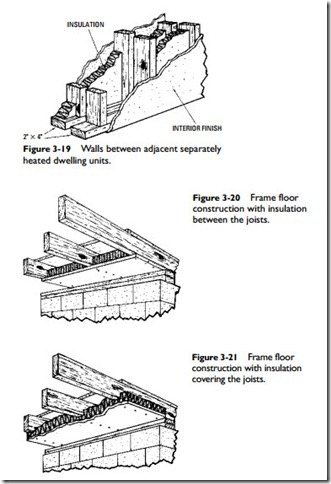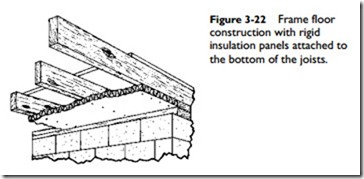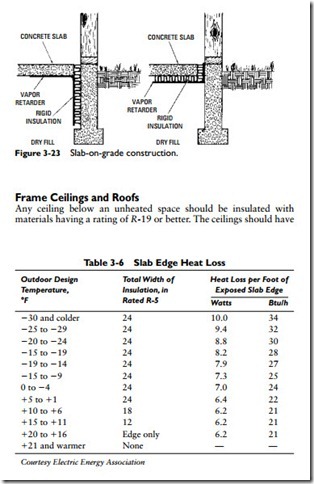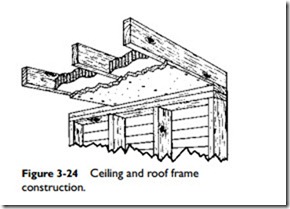Walls Between Separately Heated Dwelling Units
Where walls separating adjacent but independently heated dwelling units occur, use insulation with a thermal resistance of at least R–11. The insulation may be placed in either wall or divided propor- tionally between them (Figure 3-19).
Wood or Metal Joist Frame Floors
Wood or metal joist floors over unheated basements or vented crawl spaces should have a maximum U-value of 0.07 (requiring insulation rated at R-11 or greater). Three methods for providing insulation are illustrated in Figures 3-20 through 3-22.
Concrete Floors
Concrete floors over unheated spaces should have a maximum U- alue of 0.11, requiring insulation rated at R-7 or greater. The following three methods are recommended for applying a layer of insulation:
1. Spray rigid insulation in a suitable thickness on the underside of the floor.
2. Bond preformed rigid insulation to the top or bottom of the surface.
3. Form concrete around a core of rigid insulation.
Slab-On-Grade Floors
Structures constructed on concrete slabs are in direct contact with the ground. Unless they are properly insulated, the slab can become extremely cold and damp. Some form of insulation should be placed between the slab and the ground before the concrete is poured. Insulation can be added to an existing structure by excavating around the edges of the foundation to a level below the frost line and adding 2 in of waterproof insulating material to the sides of the slab.
Insulation rated R-5 is required for all slab-on-grade floors. Two methods for insulating slab-on-grade floors are illustrated in Figure 3-23. Table 3-6 lists the maximum heat losses in terms of watts and Btu/h per linear foot of exposed slab edge, as recommended by the Electric Energy Association. More information can be obtained from the FHA Minimum Property Standards.
a maximum U-value of 0.05. Some methods for providing such insulation are the following:
1. Staple blankets or batts to the joists before the finished ceiling is applied (Figure 3-24).
2. Blow or manually apply loose insulation between ceiling joists from above.
3. Spray on insulation between the joists from above.
Concrete Ceilings
Concrete ceilings below unheated spaces should have a maximum U- alue of 0.07, requiring insulation rated R-11 or greater. The following methods are suggested for insulating concrete ceilings:
1. Attach preformed rigid insulation to either surface with adhesives.
2. Apply sprayed-on rigid insulation to either surface.
3. Make a sandwich construction with preformed rigid insulation formed around a concrete core.
4. Apply rigid insulation to the top surface where the ceiling also serves as the roof of the structure.
Sandwich Ceilings
Ceilings of sandwich construction below unheated spaces should have a maximum U-value of 0.05, requiring insulation rated at R– 19 or better. Sandwich ceilings that also serve as the roof of a structure meet the same requirements.
Windows and Doors
Windows and doors can account for at least 30 percent of the total heat loss (or gain) in a structure. Much of this results from air infiltration through cracks around the windows and doors. This problem can be corrected by installing weather stripping, applying caulking, or installing double-glazed windows, solid wood doors, or doors with built-in insulation.
An exterior door constructed with a core of rigid insulation and faced with metal or acrylic film will have a very low U-value (as low as 0.074). Infiltration heat loss around the edges of the door can be effectively reduced with suitable weather stripping.
A typical 1-in solid wood door will have a U-value of approximately 0.64 (compare this to the U-value for the door described in the preceding paragraph). Doubling the thickness of the door will reduce the U-value to about 0.43. The addition of metal of glass storm doors will further reduce the U-value (0.39 and 0.29, respectively).
Windows with double glazing will have a U-value of 0.58, as compared to 1.13 for single glazing. Double glazing will also reduce noise transmission.



